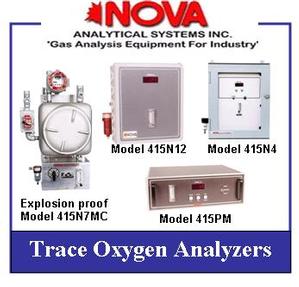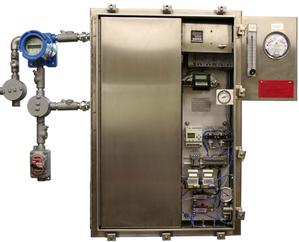The 7460 Series Portable Analyzers are available in four versions for the measurement of 2-6 of the gases found in the exhaust gases from internal combustion engines. CO, CO2, and hydrocarbons are detected by a single, dual wavelength infrared detector. Oxygen and NOx (as NO) are detectable by customer replaceable electrochemical sensors. More information
Saturday, February 21, 2009
Eurotron Portable Flue Gas Analyzers
 GreenLine, Ecoline and UniGas series have been designed to meet the demand of Portable Flue Gas Analyzers that can measure and compute exhaust emissions and efficiency.
GreenLine, Ecoline and UniGas series have been designed to meet the demand of Portable Flue Gas Analyzers that can measure and compute exhaust emissions and efficiency.Typical applications include: heating and power industry, exhaust gases from internal combustion engines, industrial plants, as well as chemical process technology, technical monitoring, servicing, environmental protection, and every situation where emissions have to be monitored and controlled.
Thanks to its compact, transportable design and simplicity of operation the Analyzer is a valuable aid for in-situ use in constantly changing measurement sites.
Oxygen Analyzers, Analyzer Trace
 Trace Oxygen Analyzer in process gas streams such as blanketing mixtures, glove boxes, electronics, research, hydrogen/nitrogen mixtures, etc.
Trace Oxygen Analyzer in process gas streams such as blanketing mixtures, glove boxes, electronics, research, hydrogen/nitrogen mixtures, etc.The Nova Model 415 Series Trace Oxygen Analyzers have been designed for the detection of trace levels of oxygen in a non-corrosive gas stream. Several types of enclosures are available including NEMA 4x/12 wall mount, panel mount, rack mount, benchtop or explosionproof.
Hydrocarbon (VOC's) in Water Monitor Analyzer

The ability to analytically quantify highly reactive volatile organic compounds (VOCs) in water is greatly enhanced with the Sample Transfer Stripper (Patented Membrane Technology) and the solid state sensor offered by Analytical mSystems International (ASI). The analyzer system utilizes many patented and exclusive features only available from ASI.
The principle of operation requires a consistent free flowing liquid sample into a Sample Transfer Stripper unit that separates the liquids from the VOCs. A hydrocarbon free, consistently flowing air carrier then sweeps the VOCs in a gaseous form into the solid state sensor for quantitative analysis in ppb w, ppm w, or up to saturation levels. An optional patented liquid validation/calibration by Perm Tube is available. This unattended on-line analysis is economically superior to inaccurate laboratory analyzers where unstable grab samples result in VOCs deterioration that produce analytical errors. Downtime is reduced to less than 10% of the El Paso, TOC or Sparger methods and the economic pay out is increased because of reduced product loss. In one case, 12,000 pounds of product loss per day was quickly identified by this proven and accurate on-line analytical method.
TCEQ letters have designated the Model 204 as ìBest Available Control Technologyî and ìEquivalencyî for continuous monitoring of cooling tower applications.
Applications include analysis of VOCs and oil in water for cooling towers, heat exchangers, holding ponds, run off water, and waste waterSaturday, February 14, 2009
The Quadrupole Mass Analyzer
Quadrupole Schematic

As ions enter the quadrupole, they begin to oscillate in both the X and Y planes. In such a system, the lower m/e ions will be destabilized in the quadrupole whenever the alternating (RF) component of the electric field exceeds the direct (DC) component. In this instance, the lower m/e ions will quickly be thrown out of the quadrupole and will not reach the detector. This mode of operation makes an effective low mass filter.
If the direct component exceeds the alternating component then the reverse is true. High m/e ions become unstable while lower m/e ions are stabilized by the presence of the alternating component. This makes an effective high mass filter.
In the quadrupole, the mass analyzer is created by connecting the two pairs of rods in such a way that the X plane acts as a low mass filter and the Y plane acts as a high mass filter. By carefully matching the two fields, only ions of a particular mass are able to resonate at the correct frequency and pass through the quadrupole at any point in time.
The quadrupole mass analyzer is a very fast and efficient system.
The High-Resolution Mass Analyzer
First, the ion beam passes through a narrow slit, which only allows those ions traveling along the correct axial plane of the mass spectrometer to pass through. This results in a narrow beam of ions all traveling parallel to each other.
The next stage of the mass analyzer is the electro static analyzer (ESA). It consists of two curved plates with applied DC voltage. The inner plate has a negative polarity, which attracts the positively charged ions, and the outer plate has a positive polarity, which repels the ions. The ion beam passes between these two plates and is both focused and curved through an angle of around 40°. Because only ions with a narrow range of kinetic energy are able to pass through the ESA, it forms an effective energy filter.
Schematic of the ion optics of the VG Axiom

The next part of the high-resolution mass analyzer is the magnet. When a charged particle passes through a magnetic field it is subjected to a force perpendicular to both its direction of travel and the direction of the magnetic field. This results in a circular trajectory with a radius proportional to the kinetic energy of the particle and its mass/charge ratio (m/e). Because the ion beam has already passed through the ESA, all ions entering the magnetic field have a similar kinetic energy. In a uniform magnetic field, the radius of curvature for particles of the same energy but of different m/e varies according to the square root of their m/e ratio.
The final part of the system is the collector slit. This is another narrow slit, situated at the focal point of the magnet. High resolutions are achieved by making both of the slits very narrow so that the beam reaching the detector has only a very narrow bandwidth of mass at any given time.
The high-resolution mass analyzer is known as a double focusing system because it is able to focus both energy and mass/charge.
Tuesday, February 3, 2009
Active Network Monitor
